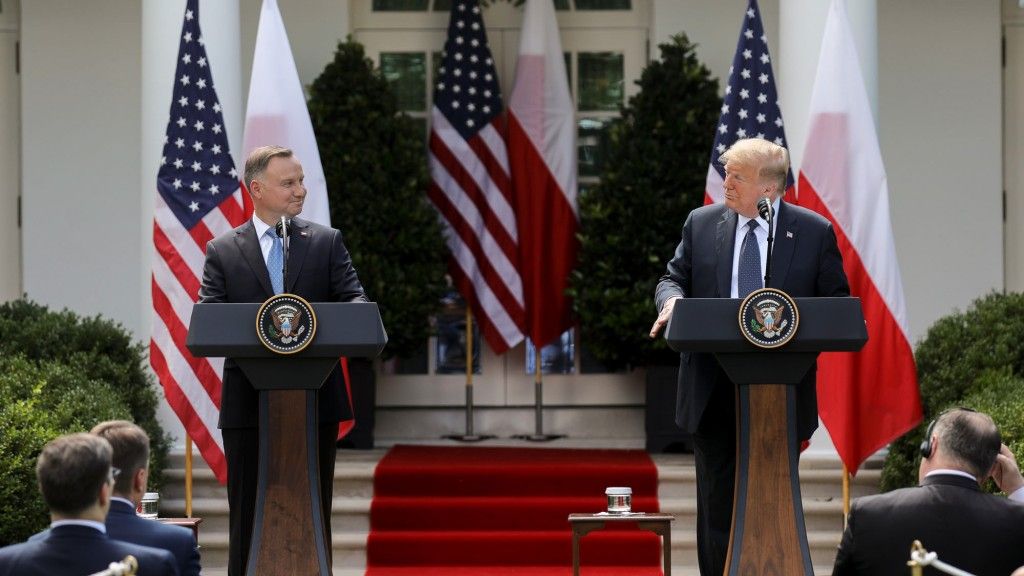Defence Policy
Washington Presidential Summit Paves Way for Strengthened Polish-U.S. Partnership

Polish President Andrzej Duda‘s June 24 visit to Washington builds on years of ever-deeper Polish-U.S. defense cooperation. This multi-dimensional partnership has enhanced the security of both countries as well as of their NATO allies. However, the latter need to step up their own efforts to realize the full interoperability and other gains from these recent Polish-U.S. initiatives – as writes Richard Weitz (PhD), senior fellow and director of the Center for Political-Military Analysis at Hudson Institute.
Poland is one of only a handful of NATO’s European members that has regularly allocated more than two percent of its GDP to defense. The government is spending almost $50 billion[1] in the next five years on sophisticated assault helicopters, submarines, cyber defenses, reconnaissance drones, and fighter planes to replace aging Soviet-era weaponry and match Russia’s military buildup.
Poland is building the most advanced air and missile defense architecture in Europe. The network will combine an upper-level layer of Patriot interceptors with a lower-level layer of indigenous interceptors. Earlier this year, Poland signed a contract to purchase 32 F-35A Lightning II fighter jets, which are becoming the backbone of NATO air power. The Aegis Ashore Missile Defense System under construction in Poland, armed with newly developed SM-3 Block IB and Block IIA interceptors, aims to defend all of NATO against long-range ballistic missiles.
Furthermore, Poland has become the first NATO country to obtain the Integrated Air and Missile Defense Battle Command System (IBCS). The system can link these air and missile defenses to detect, track, and intercept airplanes, UAVs, and cruise missiles. This past winter, the IBCS has demonstrated[2] the ability to integrate diverse sensors and shooters, including U.S. Army and Marine radars, Air Force F-35s, and Patriot interceptors against simulated attacking aerial targets.
Such layered and integrated air and missile defenses are critical[3] for protecting lines of communication linking the United States and other NATO allies with East European countries like Poland[4] on the alliance’s eastern flank. Russia’s land-based air power and missiles present NATO with a formidable anti-access, area-denial barrier that could impede the allies from moving reinforcements into Poland and other front-line countries adjoining the Russian Federation. Not only would Russian strike systems attack NATO forces directly, but they would also seek to damage the transportation and other infrastructure needed to bring these forces into battle.
Poland’s defenses will become even more important if the rumored transfer of U.S. Air Force F-16s or F-35s from Germany to Poland occurs. Basing these planes in Poland not only makes them more capable of blunting Russian aggression, but also could make them more vulnerable to Russian preemptive aggression if the planes are not adequately defended by a robust air-and missile defense architecture.
To defend against Russian kinetic, cyber, and other threats, NATO needs superior Multi-Domain Command and Control[5] to construct a seamless shield of networked plug-and-play sensors and shooters that can share a common picture of threats and select optimal means for negating them. The network should be tasked with rendering layered protection for European populations, territories, and forces on deployment, such as NATO reinforcements moving into both East Central Europe and the Middle East, where state and non-state missile threats continue to grow.
More NATO countries urgently need to follow Poland’s example and acquire advanced, interoperable sensors and interceptors to detect, track, and engage the increasingly sophisticated Russian strike threats the alliance will confront in coming years. The IBCS’ open systems architecture facilitates use of both existing and emerging defense technologies and promotes interoperability between different military services and national forces. It can provide other allies a cost-effective agile development mechanism to upgrade their existing legacy hardware (such as the Patriot) and future systems (including the F-35). A future step should be incorporating European-made defense components, such as those built in Poland and other European countries, into this architecture.
In the joint press briefing after their White House meeting, President Trump said[6] that the United States would probably increase the number of U.S. troops it would send to Poland, even as the administration was announcing cuts in future U.S. forces based in Germany. President Duda, Prime Minister Mateusz Morawiecki[7], and other Polish leaders have encouraged the United States to station more U.S. soldiers in the country to fortify NATO’s eastern flank, though U.S. officials observed during President Duda’s visit that it will take months to decide what forces might leave Germany and where they would go. Additional NATO land forces in Poland could[8] deny Russian forces the prospects of easy land grabs that could confront NATO with a fait accompli.
Poland and the United States are helping build a powerful shield to defend Europe against attacks from manned and unmanned aircraft as well as ballistic and cruise missiles. Other allies need to do their part by boosting their defense spending, upgrading their sensors and shooters, and promoting broader and deeper military integration in the air, sea, and space domains.
Richard Weitz (PhD), senior fellow and director of the Center for Political-Military Analysis at Hudson Institute
[1] https://www.defensenews.com/opinion/commentary/2020/02/20/poland-is-becoming-americas-key-nato-ally/
[2] https://news.northropgrumman.com/news/releases/northrop-grumman-simultaneously-intercepts-multiple-threats-during-flight-test
[3] https://www.defence24.com/polands-missile-defenses-are-critical-for-the-defense-of-europe-opinion
[4] https://www.bbn.gov.pl/ftp/dokumenty/National_Security_Strategy_of_the_Republic_of_Poland_2020.pdf
[5] https://www.japcc.org/multi-domain-command-and-control/
[6] https://www.whitehouse.gov/briefings-statements/remarks-president-trump-president-duda-republic-poland-joint-press-conference-3/
[7] https://www.spacewar.com/reports/Poland_hopes_to_get_some_US_troops_from_Germany_999.html
[8] https://csbaonline.org/research/publications/strengthening-the-defense-of-natos-eastern-frontier?utm_source=Strengthening+the+Defense+of+NATO%27s+Eastern+Frontier&utm_campaign=csba+-+NATO+Defense+rollout&utm_medium=email
